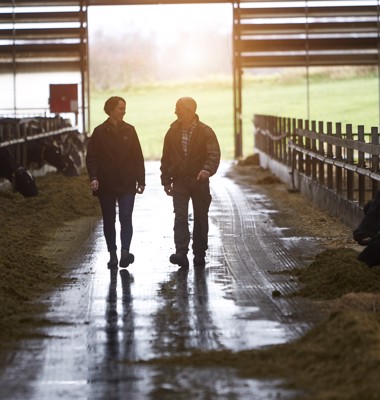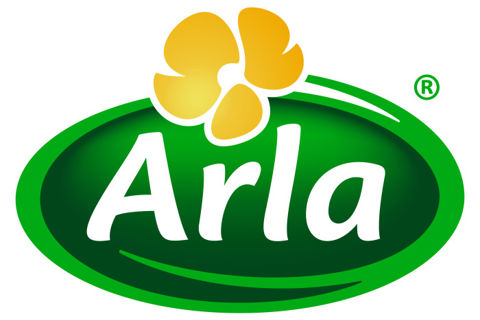Big data empowers Arla farmers to decarbonise dairy at a faster pace
- Read time:
- 8 min

- Published:
- 26 April 2021
- Contacts:
- Press contact
Arla’s Climate Checks programme, which is one of the world’s largest externally validated set of climate data from seven European countries confirms that Arla farmers are making strides to become more sustainable. It also provides Arla farmers a clear blueprint of what will drive further reductions of greenhouse gas emissions on their farms over the next decade.
For the last decades, Arla farmers have been working steadily towards sustainable farming and implementing green opportunities on their farms, such as circular farming practices, renewable energy and biodiversity and now also Climate Checks. A total of 7,986 farms across seven European countries have concluded a Climate Check using Arla’s new standardised tool for identifying carbon footprint and the data shows that they are making progress in their ambition to become more sustainable .
“We have made a major investment in developing and implementing a solid model for measuring climate impact on a dairy farm. The unique data set that Arla farmers have now created clearly shows which activities will accelerate our reductions over the next decade. We will use this to decarbonise our farms at a faster pace and share our findings with stakeholders to help drive an effective transition for the whole industry. There’s a huge amount of value in this for all of us,“ says Arla Foods Chairman Jan Toft Nørgaard.
The independent sustainability Think Tank, The Institute for Environmental Policy (IEEP) says of Arla’s climate checks:
“A year ago we published a report for ARLA Foods aiming at going beyond fact checking and turning the existing evidence into a practical, solution-focused pathway towards what could be a more sustainable dairy industry. It is certainly now very encouraging to see Arla taking the initiative to put sustainability at the core of their decision making and developing tools to measure their impact on the ground and adapt their practices. These sorts of initiatives can be an example for the dairy industry,” says Céline Charveriat, IEEP Executive Director.
Five universal levers
The data has revealed five universal levers to a lower carbon footprint for dairy on all types of Arla farms. They are:
- Better feed efficiency to improve milk yield
- Precision feeding to reduce surplus protein in feed rations
- A healthy and long life for the cow to improve milk yield
- Precise fertilizer management to reduce nitrogen surplus from feed production
- Better land use management to ensure better crop yields
The areas targeted by the five big levers are explaining the majority of the differences between the individual farms’ carbon footprints. The five levers apply to all Arla farms in the UK, Sweden, Denmark, Germany, the Netherlands, Belgium and Luxembourg regardless of size, geography, breed or landscape conditions.
“The data shows that all types of farms can achieve tangible results if precision farming is increased in these five areas. This helps us significantly going forward both to lower our CO2e footprint and for future investments on farms to help meet our ambitious climate goals,“ says Jan Toft Nørgaard.
A baseline, not a result
A total of 7,986 Arla farmer owners have assessed and submitted data to 203 questions about their herd, feed production, energy usage etc. Their data has been verified by an external climate advisor, who has also helped create the farmer’s action plan for further climate reductions based on the individual data.
The data confirms that Arla farmers dairy farmers produce with 1.15 kg of CO2e per kilo of milk including peat lands.
“We are proud of where we’ve got to, but we are determined to go a lot further. For us, the number is not a final result but a baseline from where we need to improve. The Climate Checks is a tool to guide our next steps, to accumulate more insight and transparently measure our progress going forward,” says Jan Toft Nørgaard.
As the next round kicks off in June, Arla farmers will get access to a new digital tool that enables them to follow their own progression and to benchmark against data from other Arla farms. What is particularly interesting is to learn from the high-performers. The data shows that the best performing Arla farmers are able to produce a kilo of raw milk with a farm level footprint well below 0,9 kg of CO2e.
Data to improve common knowledge of most effective measures
The insights generated from the compiled data will be shared within the cooperative and also presented to politicians, research partners and industry stakeholders to improve the common understanding of what works and where to focus funding and research to support the longer-term transition on farms. It can also counter some of the myths and assumptions about what needs to be done on farm.
“Dairy has been an important and established part of many food cultures and economies around the world for many years because of its nutrient density, high quality proteins, versatility and taste. Within the industry we have always been clear about the responsibilities we carry to de-carbonise our production, however, there has been a lack of robust data at farm level to enable fact-based decision making and investment,” says Jan Toft Nørgaard.
There are still effects of dairy farming that are not fully scientifically understood. One example is carbon sequestration that can potentially be an important positive lever to mitigate climate change, not least for dairy farmers who have a lot of grasslands. Arla is part in a collaboration with FrieslandCampina, Fonterra, Mars, McDonalds and Nestle among others to develop internationally recognised and globally adopted carbon sequestration calculation guidelines for the dairy sector and when these are in place the aim is to include the impact of carbon sequestration in the Climate Check measurement.
The relatively low average footprint for Arla’s raw milk at farm level is a result of year-on-year improvements made by the cooperative’s farmers over the past three decades. In this decade of action, they aim to triple the speed of reductions to meet Arla’s science-based target of -30 per cent CO2e per kg of milk from 2015 to 2030 and to become carbon net zero by 2050.
Overall, the number of dairy cows in Arla’s core European markets have declined with between 50 and 80 per cent since 1950 while producing the same amount of milk with a significantly lower carbon footprint per kilo. This has been possible due to better animal welfare, strong farm management and new technologies.
Read more about How We Measure Dairy Farming's Carbon Footprint Read more about How Arla farmers reduce dairy's carbon footprint
-------
CLIMATE CHECKS FACT BOX:
- A total of 7,986 Arla farmers, covering 95% of Arla’s milk pool, have participated in Climate Checks in 2020.
- Arla farmers produce raw milk as it leaves the farm with 1.15 kg of CO2e per kilo of milk including emissions from cultivated carbon rich soils (peat lands) as this is the international guideline. Without peat lands the average is 1.06 kg of CO2e per kilo of milk.
- The farmers have assessed and submitted data from their farms to 203 questions.
- Climate Check data covers number of animals, feed composition, crop production, use of fertilizer, manure handling, use of electricity, fuel and renewable energy.
- Climate Checks are based on ISO (14044) standards for life cycle assessment and follows the International Dairy Federation (IDF) guidelines on Carbon Footprint methodology, while emissions from animals, manure and soils are based on IPCC (Intergovernmental Panel on Climate Change).
- The tool is developed together with 2.0 LCA Consultants
- According to the UN’s Food and Agricultural Organisation (FAO) global milk production emits an average of 2.5 kg CO2e per kg of milk.
Climate Checks examples of Arla farmers’ handprints that has a positive impact on climate:
Arla farmers contribute to the transition to green energy:
Using manure to produce biogas is a truly circular process creating a closed-loop system as the remaining degassed biomass can be circulated back the farms afterward as a higher value fertilizer, which is more nutritious and odourless than the original manure.
11 per cent of Arla farmers have a biogas generator on the farm or are delivering manure for external biogas production, some of which are initiated by Arla to accelerate the transition to green fuel for its fleet of milk trucks and distribution vehicles.
24 per cent of Arla’s cooperative farmer owners also generate green electricity on their farms from solar panels and wind turbines. They use it to power their own farms, which enables them to reduce the total carbon footprint of their milk. The surplus electricity is sold to the public grid.
Arla farmers produce feed locally
Arla farmers feed their cows mainly with feedstuff grown on or close to the dairy farm. Local protein production is better for the climate than for example imported soy protein transported over a long distances.
On average 62 per cent of all protein that Arla farmers feed to their cows are homegrown on their own farm. Homegrown protein comes mainly in the form of grass- and clover grass but also as peas, beans or other grains.
The majority of externally purchased feed is sourced within Europe, where Arla farmers live. The share of soy that Arla farmers use range between zero to 10 per cent and all soy used on Arla farms is either organic, ProTerra certified, RTRS (Round table Responsible Soy) or covered by RTRS certificates.
Grasslands are integral to dairy farming
Grasslands do not only provide nutritious feed for the dairy cows and benefit a fertile soil but are also considered to have the potential to play a key role in greenhouse gas mitigation, particularly in terms of carbon sequestration. Carbon sequestration is not yet included in the calculations in Arla’s Climate Checks, however the management of grassland is already in focus as a lever to reduce the carbon footprint.
58 per cent of the total hectares that Arla farmers are responsible for are grassland. Around half of these are grassland in rotation, which means that every third or fourth year other crops are grown on the land. Grasslands in rotation are typically mixtures between grasses and clover providing natural fertilizers for the next crops in the rotation.
Half of the grasslands are permanent, which means they have been out of crop rotation for more than five years. Permanent grasslands are not only valuable for carbon storage but also for soil fertility and for stopping soil erosion, which are alle helpful in adapting to climate change.
32 per cent of the permanent grasslands are semi-natural extensive grasslands that become ecosystems that include wild plants and fungi, boost pollinators and create landscape values.
Arla Foods is an international dairy company owned by more than 8,400 farmers from Denmark, Sweden, the UK, Germany, Belgium, Luxembourg and the Netherlands. Arla Foods is one of the leading players in the international dairy arena with well-known brands like Arla®, Lurpak®, Puck® and Castello®. Arla Foods is focused on providing good dairy nourishment from sustainable farming and operations and is also the world's largest manufacturer of organic dairy products.
Press contact
